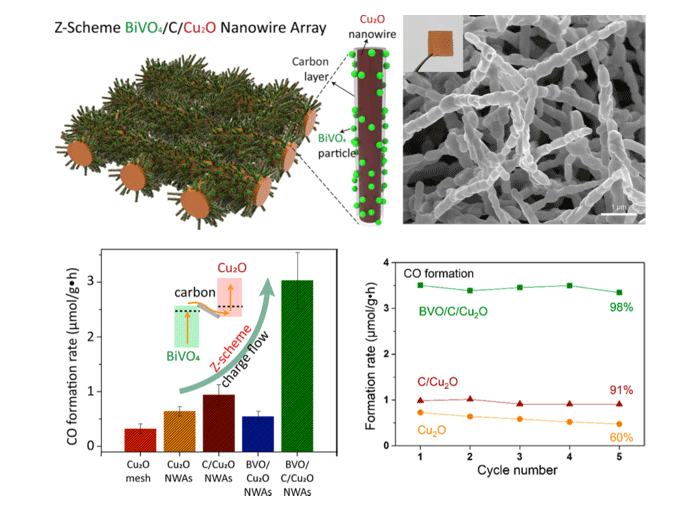As a research project of the Saudi Aramco – KAIST CO2 management center, Professor Hee-Tae Jung and his research team studied the development of a highly efficient nanostructured photocatalysts for CO2 conversion. Photocatalytic conversion of CO2 into useful chemicals or fuels is one of the most attractive and promising areas of research that can resolve both environmental issues and the energy crisis. However, the photocatalysts developed thus far suffer from quite low CO2 photoconversion efficiency due to electorn-hole recombination, a narrow scope of light absorption, small surface area, and low photovoltage.

Professor Hee-Tae Jung and his research team constructed a Z-scheme charge flow on a 3-dimensional nanowire array structure. They selected Cuprous oxide (Cu2O) as a CO2 reduction semiconductor, which can absorb visible light and produce electrons with sufficient potential energy for CO2 photoreduction. By nano-structuring Cu2O nanowire arrays, high surface area with improved light harvesting was obtained. At the same time, charge recombination can be significantly reduced with Z-scheme charge flow by incorporating Bismuth vanadate (BiVO4) as a water oxidation catalyst. Also, a carbon layer between two semiconductors enhanced stability and induced efficient Z-schematic charge transfer. Through the above strategies, the photocatalytic CO2 conversion performance of BiVO4/carbon coated Cu2O nanowire arrays featured a CO formation rate of 3.01 micromole/g/h in a humidified CO2 gas condition, which is 9.4 and 4.7 times higher than the values of Cu2O mesh and Cu2O nanowire arrays, respectively. The photocatalyst also exhibited outstanding stability by retaining 98% of the initial formation rate after 20 hours of reaction. This research suggested a novel model for the conversion of CO2 using low cost materials and solar energy. This work was published in ACS Catalysis in April 2018.
Prof. Hee-Tae Jung (Department of Chemical & Biomolecular Engineering)
Homepage: http://ooem.kaist.ac.kr
E-mail: heetae@kaist.ac.kr






